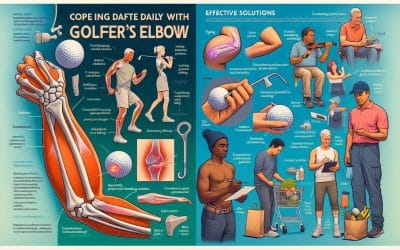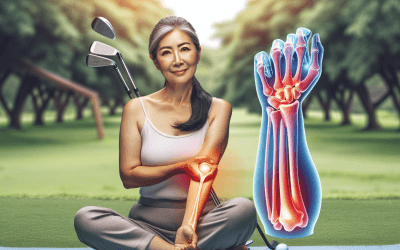Discover effective pain management strategies for golfer’s elbow at Eastside Ideal Health. Alleviate discomfort, enhance healing, and improve your game.
Relieve Elbow Pain and Restore Strength
Golfer’s Elbow Treatment in Redmond, WA
Feel the Difference Expert Care Makes
Located near Microsoft campus in Redmond, WA
Reduce Inflammation, Support Healing, Prevent Recurrence
You don’t have to swing a golf club to suffer from Golfer’s Elbow. Also known as medial epicondylitis, this overuse injury affects the inner elbow and forearm—and it can impact everything from lifting weights to opening a jar. At Eastside Ideal Health, we provide targeted, conservative care to relieve pain, restore function, and prevent future flare-ups.
What Is Golfer’s Elbow?
Golfer’s Elbow is a condition where the tendons that attach to the inside of the elbow become inflamed or degenerated due to repetitive stress. It's common in golfers, but also in:
- Weightlifters and CrossFit athletes
- Construction and trade professionals
- Office workers using poor wrist mechanics
- Tennis or throwing athletes (when strain affects both sides of the elbow)
Symptoms of Medial Epicondylitis
- Aching or burning on the inner elbow
- Forearm tightness or weakness
- Worsening pain with gripping, lifting, or wrist flexion
- Stiffness and tenderness near the bony bump on the inside of your elbow
How We Evaluate Golfer’s Elbow
Our diagnostic process includes a detailed functional assessment, including:
- Palpation and orthopedic testing of the medial elbow
- Range of motion, strength, and grip evaluation
- Postural and shoulder mechanics review
- Ultrasound or imaging referral if symptoms persist or worsen
We aim to identify contributing factors throughout the kinetic chain, not just treat the elbow in isolation.
Chiropractic Treatment Options
Your treatment plan may include a combination of:
- Joint adjustments of the wrist, elbow, and cervical spine to restore alignment
- Soft tissue therapy, including myofascial release and trigger point work
- Instrument-assisted techniques like Graston or IASTM to break down scar tissue
- Laser therapy or heat modalities to reduce inflammation and promote healing
- Corrective exercises for eccentric strengthening of the forearm flexors
- Bracing and ergonomic education to reduce repetitive stress
Proven Conservative Care
"The majority of medial epicondylitis cases respond well to non-surgical treatment, including manual therapy and eccentric exercise programs."
When to Seek Advanced Imaging or Referral
We typically recommend referral if you experience:
- Severe or worsening pain despite treatment
- Loss of grip strength or signs of nerve involvement
- Injury accompanied by swelling, bruising, or trauma
Most patients, however, recover fully without injections or surgery.
Frequently Asked Questions
- Is this the same as Tennis Elbow?
- No. Golfer’s Elbow affects the inside of the elbow, while Tennis Elbow (lateral epicondylitis) affects the outside. The mechanism and treatment are similar, but the structures involved differ.
- Can I still work or lift while receiving care?
- In many cases, yes—with modification. We'll guide you on when to rest and how to scale your activity safely.
- How long does recovery take?
- Recovery varies, but most patients see improvement within 4–8 weeks with consistent treatment and exercise.
Book Your Elbow Evaluation Today
Whether you're an athlete, tradesperson, or desk worker, we’re here to help you move pain-free. Book your consultation at Eastside Ideal Health in Redmond and get back to doing what you love—without elbow pain holding you back.
Related Services:
“
Testimonials
Targeted Relief for Inner Elbow Pain
Chiropractic techniques help reduce inflammation and tension in the tendons responsible for golfer’s elbow discomfort.
Hands-On Therapy That Works
Manual adjustments, soft tissue work, and mobility exercises are used to restore function and ease pain in the forearm and elbow.
Support for Long-Term Recovery
Our care plans include corrective exercises and ergonomic guidance to help you heal properly and avoid flare-ups down the road.
Learn More About Golfer’s Elbow Treatment
Golfer’s Elbow Treatment Resources
The Role of Nutrition in Golfer’s Elbow Recovery
Discover how nutrition plays a vital part in recovering from golfer’s elbow. Eastside Ideal Health guides you with effective strategies for a swift recovery.
How to Manage Emotional Well-Being with Golfer’s Elbow
Discover effective ways to handle emotional well-being while dealing with golfers elbow. Eastside Ideal Health has the answers you need to stay balanced and healthy.
How to Improve Daily Function with Golfer’s Elbow
Discover effective ways to enhance daily function if you have golfer’s elbow. Eastside Ideal Health offers expert solutions for improved quality of life.
How to Use Lifestyle Changes for Golfer’s Elbow Pain Management
Learn effective ways to manage golfer’s elbow pain with lifestyle changes. Eastside Ideal Health provides expert tips for pain management and relief.
The Importance of a Balanced Diet for Golfer’s Elbow Recovery
Discover the significance of a balanced diet for recovering from golfer’s elbow. Eastside Ideal Health is here to guide you towards a healthier lifestyle.
Contact Us For An Appointment
Get Relief
Clinic Hours
Monday-Friday: 730am - 6pm
Saturday: 9am - 12pm
Sunday: Closed






